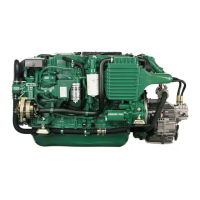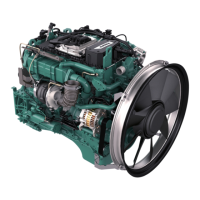39
1
2
3
Fuel system
All work on the engine injection pump or injectors must be carried out at an authorized workshop. Use only the
recommended grade of fuel: See the chapter “Technical Data”.
WARNING! Fire risk. When carrying out work on the fuel system make sure the engine is cold. A fuel spill
onto a hot surface or an electrical component can cause a fire. Store fuel soaked rags and other flammable
material in fireproof conditions.
Venting the fuel system
The fuel system must be vented after the fuel filters
have been replaced or after refilling the fuel tank after
it has been run dry.
1. Open vent screw (1) on the filter mounting approxi-
mately four turns. Avoid fuel spillage. Use rags
around the venting point.
2. Pump the fuel using hand pump (2) until there are
no more air bubbles visible in the fuel. Continue
pumping and at the same time tighten the venting
screw. If the pump effect is poor, turn the engine
over slightly so that the pump drive cam changes
position.
If the engine does not start continue venting as
follows:
3. Use the handpump (2) and pump for about half a
minute to automatically vent the fuel injection
pump.
4. Slacken off the injector delivery line nuts and set
the engine speed control to wide open throttle
(WOT). Turn the engine over with the starter motor
until fuel comes out of the delivery lines. Avoid
fuel spillage. Tighten delivery line nuts.
5. Start the engine and check for leaks.
WARNING! Approaching a running engine is
dangerous. Watch out for rotating components
and hot surfaces.
Emergency stop
Should the normal stop function not operate the
engine can be stopped by pulling the fuel injection
pump lever (1) to the rear.

